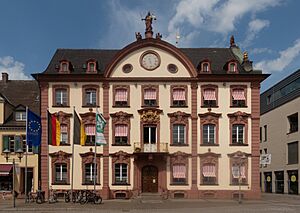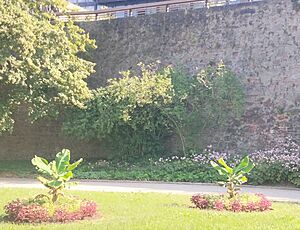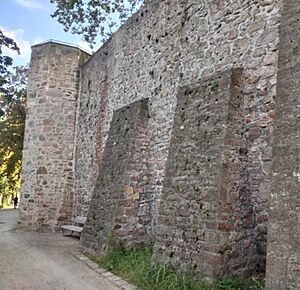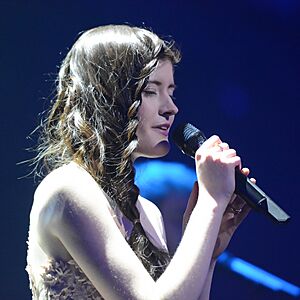Offenburg facts for kids
Quick facts for kids
Offenburg
|
|||
|---|---|---|---|
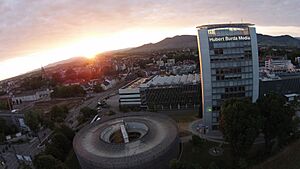
Aerial view
|
|||
|
|||
| Country | Germany | ||
| State | Baden-Württemberg | ||
| Admin. region | Freiburg | ||
| District | Ortenaukreis | ||
| Elevation | 163 m (535 ft) | ||
| Population
(2022-12-31)
|
|||
| • Total | 61,670 | ||
| Time zone | CET/CEST (UTC+1/+2) | ||
| Postal codes |
77652, 77654, 77656
|
||
| Dialling codes | 0781 | ||
| Vehicle registration | OG, BH, KEL, LR, WOL | ||
Offenburg is a city in the state of Baden-Württemberg, located in southwestern Germany. Its name means "open borough," which is shown by the open gates on its coat of arms.
With almost 60,000 people living there in 2019, Offenburg is the largest city in the Ortenaukreis region. It also serves as the main administrative center for the area.
Contents
A Look at Offenburg's Past
Early Beginnings and Imperial City Status
Long ago, the Romans had settlements in the area where Offenburg is today. The city was first mentioned in official papers in 1148. By 1240, Offenburg was declared a Free Imperial City. This meant it was a special city that ruled itself, reporting directly to the Holy Roman Emperor.
Destruction and New Rulers
However, in September 1689, during the Nine Years' War, French forces almost completely destroyed the city. Only two buildings were left standing. Later, in 1803, Napoleon changed the map of Germany. Offenburg lost its special status and became part of the Grand Duchy of Baden.
The Fight for Democracy
In 1847, a very important event happened in Offenburg. People gathered at the Salmen Inn and created the "Offenburger Programm." This was a list of thirteen demands for more democracy in Germany. It asked for basic human rights, freedom of the press, and fair taxes. These demands were supported by 20,000 people in 1848.
Offenburg During World Wars
During World War I, Offenburg was one of the first cities to be attacked from the air. Airplanes bombed the railway lines. After the war, French troops occupied Offenburg from 1923 to 1924. They blocked railway traffic in the area.
In the 1930s, when the Nazis came to power, the Jewish people in Offenburg faced harsh treatment. Their local synagogue was damaged in 1938. Many Jewish residents who could not leave were later sent to concentration camps during World War II.
Offenburg was also home to prisoner-of-war camps for Allied soldiers during World War II. Because it was close to the French border, the city faced artillery fire. On November 27, 1944, over 300 American bombers attacked the railway yards. French forces entered Offenburg on April 15, 1945. The city then became part of the French Zone of Occupation until West Germany was formed in 1949.
Growth After the War
Since 1949, Offenburg has grown a lot. Between 1971 and 1975, eleven nearby villages joined the city. This helped Offenburg become bigger and more successful.
Offenburg's Location
Offenburg is about 15 kilometers (9 miles) east of the Rhine river. It lies between the cities of Karlsruhe and Freiburg. The French city of Strasbourg is about 20 kilometers (12 miles) northwest, across the Rhine.
The city is located where the Kinzig river valley begins, right at the foot of the Black Forest. The Kinzig river flows from the Black Forest and joins the Rhine near Kehl.
Weather in Offenburg
Offenburg has an oceanic climate, which means it has mild weather. Winters are cool, and sometimes there are frosts at night. Most of the rain falls during the summer months.
| Climate data for Offenburg (normals 1991-2020) | |||||||||||||
|---|---|---|---|---|---|---|---|---|---|---|---|---|---|
| Month | Jan | Feb | Mar | Apr | May | Jun | Jul | Aug | Sep | Oct | Nov | Dec | Year |
| Daily mean °C (°F) | 2.6 (36.7) |
3.6 (38.5) |
7.2 (45.0) |
11.2 (52.2) |
15.3 (59.5) |
19.8 (67.6) |
20.6 (69.1) |
20.0 (68.0) |
15.7 (60.3) |
11.1 (52.0) |
6.4 (43.5) |
3.6 (38.5) |
11.4 (52.6) |
| Average precipitation mm (inches) | 55.9 (2.20) |
51.4 (2.02) |
57.9 (2.28) |
59.0 (2.32) |
94.7 (3.73) |
86.0 (3.39) |
89.5 (3.52) |
84.4 (3.32) |
64.9 (2.56) |
76.0 (2.99) |
68.1 (2.68) |
67.6 (2.66) |
855.4 (33.67) |
| Mean monthly sunshine hours | 54 | 82 | 138.9 | 185.1 | 210.4 | 231.1 | 245.6 | 230 | 171.2 | 103.9 | 56 | 41.3 | 1,749.5 |
| Source: Deutscher Wetterdienst | |||||||||||||
Offenburg's Economy
Offenburg has a strong economy with many businesses and factories. It is home to several well-known companies.
Factories and Industries
Many important manufacturing companies are based in Offenburg. These include tesa-Werke Offenburg GmbH, which makes adhesive tapes. Vivil produces sweets and candies. MEIKO Maschinenbau GmbH & Co. KG makes professional dishwashing and cleaning systems. Hansgrohe SE creates bathroom and kitchen fittings. HOBART GmbH makes kitchen equipment for businesses. There are also many smaller companies that make special high-quality products.
Trade and Retail
One of the biggest employers in Offenburg is EDEKA Handelsgesellschaft Südwest mbH. This is a large German supermarket company with a big production, storage, and distribution center in Offenburg. Printus GmbH is a company that sells office supplies and has many employees. Several companies related to Markant AG, which deals with food and non-food items, are also located here.
Publishing and Printing
Hubert Burda Media is one of Germany's largest publishing companies. Together with its printing factories, it employs many people in Offenburg. The growth of Franz Burda's printing business and the success of his wife Aenne Burda's Burda Style magazine helped Offenburg's economy grow after World War II. They also made the city famous around the world.
Getting Around Offenburg
Offenburg is in a great location for travel. Important roads and railway lines have passed through here since Roman times.
Roads
Offenburg is just 3 kilometers (2 miles) east of the A 5 federal motorway. It has been connected to this major highway since 1960. Two other important federal roads, the B 3 and B 33, also meet in Offenburg.
Trains
Offenburg became a major railway center in the 1800s and early 1900s. Today, Offenburg station is a busy hub for several train lines. The most important is the Rhine Valley Railway. This line connects Karlsruhe and Basel. You can catch fast ICE trains from Offenburg to cities like Berlin, Cologne, Frankfurt, and Amsterdam.
The beautiful Black Forest Railway also starts in Offenburg. There are also lines to Strasbourg and the Rench valley. Since 2018, you can even take a direct TGV train from Offenburg to Paris-Est almost every day.
Air Travel
Offenburg airfield (EDTO) has been used for flying since 1911. It has a paved runway. However, it is mostly used by local flying clubs now. You need special permission to land there. Larger airports nearby with regular flights include Lahr (EDTL), Strasbourg-Entzheim (LFST), and Baden-Söllingen (EDSB).
Learning in Offenburg
Offenburg has many schools for different age groups. It is also home to the University of Applied Sciences Offenburg. This university has its main campus in Offenburg and another campus in Gengenbach, which is nearby.
Offenburg's Historical Sights
Offenburg has several interesting historical places to visit:
- Hirschapotheke: This is an old pharmacy built in 1698. In front of it is the Löwenbrunnen (Lions' Fountain), which dates back to 1599.
- City Hall: The main city building was first built in 1521 and later made bigger in a fancy Baroque style in 1741.
- Saint Ursula's Column: This column in the Market Place was put up in 1961. A legend says that Saint Ursula saved the city during the Thirty Years' War in 1631.
- The Salmen Inn: This is where the important "Offenburger Programm" was created in 1847.
- The Capuchin Monastery: A historic monastery belonging to the Capuchin order.
- The Ritterhaus: This manor-house from 1784 is now used as the city's archives and museum.
- The Jewish Bath (Mikveh): This was a bathhouse for the city's Jewish community. It is believed to be from the 16th or 17th century.
- The Former Royal Palace (Königshof): Built between 1714 and 1717, this building now houses the police station.
- Medieval City Wall: You can still see a part of the old city wall, built in the 11th century. It is about 1,340 meters (4,400 feet) long. The Zwinger Park in front of the wall, with its banana trees, is also a nice place to visit.
- Protestant Church (Evangelische Stadtkirche): This church was built in a Neo-Gothic style from 1857 to 1864. Its tower was damaged during World War II.
- Holy Trinity Church (Dreifaltigkeitskirche): Built from 1906 to 1908 in a Neo-Romanesque style, this church was also damaged in World War II.
- Church of the Holy Cross (Heiligkreuzkirche): This church was first built in the 13th century. It burned down in 1689 and was rebuilt at the end of the 17th century.
Sports in Offenburg
Offenburger FV is a German football club based in Offenburg. It is known as one of the most successful amateur football clubs in Germany.
Famous People from Offenburg
Many notable people have connections to Offenburg:
- Wolfgang Dachstein (1487–1553), an organist and composer.
- Lorenz Oken (1779–1851), a famous naturalist.
- Josef Kohler (1849–1919), a German lawyer, writer, and poet.
- Baron Lothar von Seebach (1853–1930), a painter and designer.
- Aenne Burda (1909–2005), a well-known publisher and honorary citizen of the city.
- Hubert Burda (born 1940), also a publisher and honorary citizen.
- Jürgen Todenhöfer (born 1940), an author, journalist, and politician.
- Michael Kaeshammer (born 1977), a Canadian pianist and composer.
- Madeline Juno (born 1995), a singer-songwriter.
Sports Stars
- Christine Gossé (born 1964), a French rower who won a bronze medal at the 1996 Summer Olympics.
- Martin Wagner (born 1968), a footballer who played many games, including for the German national team.
- Atika Bouagaa (born 1982), a volleyball player.
- Felix Roth (born 1987), a former footballer.
Offenburg's Sister Cities
Offenburg is twinned with several cities around the world. This means they have special friendly relationships and often exchange visits.
 Lons-le-Saunier, France (since 1959)
Lons-le-Saunier, France (since 1959) Weiz, Austria (since 1964)
Weiz, Austria (since 1964) Borehamwood, England, United Kingdom (since 1982)
Borehamwood, England, United Kingdom (since 1982) Altenburg, Germany (since 1988)
Altenburg, Germany (since 1988) Olsztyn, Poland (since 1999)
Olsztyn, Poland (since 1999) Pietra Ligure, Italy (since 2007)
Pietra Ligure, Italy (since 2007)
See also
 In Spanish: Offenburg para niños
In Spanish: Offenburg para niños




